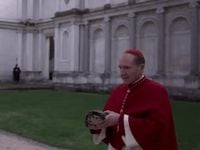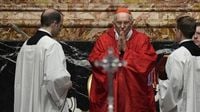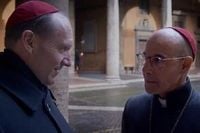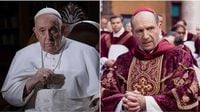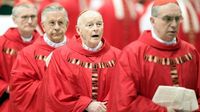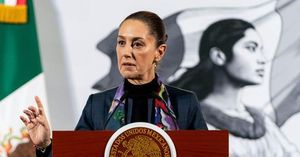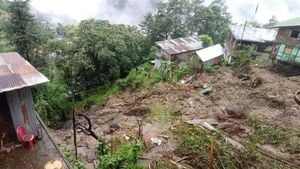The world is about to witness the process of choosing a new Pope, or rather not witness it, as the Oscar-winning film Conclave makes clear. The election of a new Pope is the most secretive democratic process in the world, conducted by 120 cardinals behind closed doors. In fact, the film shows it as being more open than it really is; in reality, the President of the College of Cardinals would face excommunication for briefing the media during this time.
The Camerlengo, or Chamberlain, of the Holy Roman Church, is responsible for declaring a Pope dead in the presence of the Papal Master of Ceremonies and a handful of other members of the Papal household. Following the Pope's death, a nine-day mourning period is declared, during which the body lies in state in St. Peter's Basilica. It will be at least 15 days before the Conclave—literally "cum clave," meaning "with key" in Latin—begins, allowing cardinals to arrive in Rome from around the globe.
While the cardinals are no longer locked away in a building until they reach a decision, they will stay at St. Martha's House within the Vatican's walls, where they have access to cooks, housekeepers, and medical services. Interestingly, cardinals over the age of 80 are not permitted to vote.
Each day, the cardinals will don their blue cassocks and red sashes and walk to the Papal Palace or the Sistine Chapel for the voting process. They are forbidden from reading newspapers, accessing radio, television, or the internet, and from sending or receiving any messages from the outside world. They may be sequestered for an extended period; indeed, the longest conclave in history lasted 34 months, from the death of Clement IV in November 1268 until the election of Gregory X on September 1, 1271. In modern times, however, no conclave has lasted longer than the five days it took to elect Pius XI in 1922. The conclave to elect Pope Francis in 2013 lasted just two days.
There is no strict procedure for the multiple ballots that may be held; the conclave will determine its own rules. If a candidate receives a two-thirds majority of votes, they are elected. Otherwise, multiple rounds of voting may narrow candidates down to a final two, with a simple majority deciding the winner.
The latest rules regarding the conclave, established in 1996 by Pope John Paul II, do not specify that the conclave must announce its decision by blowing white smoke up the chimney, a tradition that caused embarrassment in 1958 when Vatican Radio misinterpreted the smoke signals and announced the news a day early. One aspect the film captures accurately is the wide array of candidates from around the world. Although the Cardinals are not limited to choosing from among their number, it is almost certain they will do so.
Pope Francis' unexpected death during Easter has shocked the world. His passing came at the age of 88, following a long battle with double pneumonia. The significance of his death has drawn attention to the upcoming conclave and the future of the Catholic Church. This traditional process, which has been in place for over 800 years, holds immense importance for both the Church and its followers.
The film Conclave, starring Ralph Fiennes as Cardinal Thomas Lawrence, mirrors the real-life drama of papal succession. The film begins with the death of a pope and the urgent gathering of the College of Cardinals, reflecting the current situation in the Vatican. It explores the political, personal, and spiritual conflicts that arise during the conclave, presenting a narrative that resonates with the ongoing challenges facing the Church.
Fiennes’ character navigates through the complexities of the election process, highlighting the stakes involved and the diverse perspectives among the cardinals. The film envisions candidates with a radical diversity of outlooks: a progressive, a traditionalist, a moderate, and a social conservative. It raises concerns about how both internal and external factors may influence the outcomes, set against a backdrop of global chaos.
As the world awaits the white smoke to rise from the chimney of the Sistine Chapel, Conclave serves as a timely reflection on the intricacies of electing a new pope. The film does not shy away from exploring deeper questions about identity, tradition, and what leadership means in an evolving Church. The stakes are high, and the outcomes will undoubtedly shape the Church's future.
In the midst of this, the film also touches on themes of tolerance and uncertainty. Cardinal Lawrence, in a pivotal moment, states that the greatest threat to the Church is not doubt, but certainty. This perspective challenges the conservative ideology that often dominates discussions within the Church.
The film's conclusion features two significant surprises: Cardinal Benitez, a newly appointed cardinal from Kabul, wins the papal election, and it is revealed that he had visited a sex change clinic in Switzerland. This revelation opens discussions about the complexities of identity and the potential for intersex individuals within the Church's hierarchy.
In an interview with America magazine, Dr. Kurt Martens, a canon law professor, noted that "canon law says nothing about intersex people," suggesting that the Church may need to adapt its understanding of identity in light of contemporary developments.
As the world watches the conclave unfold, the film Conclave serves as a reminder of the importance of embracing diversity and complexity within the Church. The final words of the newly-elected Pope Innocent resonate deeply: "I am what God made me. And perhaps it is my difference that will make me more useful." This message offers comfort to those who live between the world’s certainties and highlights the need for a Church that is adaptable and inclusive.
